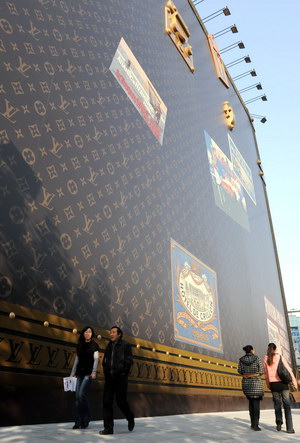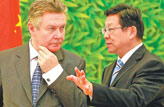Economy
Sitting in the lap of luxury
Updated: 2011-07-18 09:05
By Shi Jing (China Daily)
China is galloping. By the end of May, the country had already taken 27 percent of the global luxury market, slightly lower than Japan's 29 percent.
 |
|
A Louis Vuitton advertising logo in Shanghai. Surges in the prices of luxury goods have failed to dampen demand for such high-end brands in China. [Photo/China Daily] |
The devastating earthquake and ensuing tsunami that hit Japan in March has greatly impaired both the purchasing power of Japanese consumers and the confidence of many luxury brands.
"Hermes Group, LVMH, PPR Group and the Richemont Group all held board meetings recently to adjust their plans for Japan," said Michael Ouyang, CEO of the WLA's China office.
"More than 70 percent of the brands will try to accelerate a shift in their development focus from Japan to China this year," he added.
The robust growth of the Chinese luxury market in the first five months of this year allowed the WLA to predict that China will contribute more than $14.6 billion to the global luxury-goods market in 2012, to become the global leader.
They have also predicted that the room for growth in markets such as the United States, Japan and Europe will be quite limited in the next three years in terms of luxury-goods consumption. Therefore, China will grow to become the hub of the luxury market.
This year will mark a milestone in the expansion of these international luxury brands, according to the WLA. As China is now home to almost two-thirds of these brands, smart company heads will work out better plans for China within two years. By the end of 2013, all the luxury brands will be found in China.
The industry giants have already probed the Chinese market and their next steps are clear: for first-tier brands, such as Louis Vuitton and Gucci, which have a longer history in China and stable foundations in first-tier Chinese cities, their next step will be expansion into second-tier cities. The 10 most hotly contested cities will include Ordos in the Inner Mongolia autonomous region,Taiyuan in Shanxi province, Tangshan in Hebei province, Hefei in Anhui province, and Qingdao in Shandong province.
Louis Vuitton, for instance, opened stores in 10 Chinese cities in 2005, but by the end of last year it had 36 stores in 29 cities, including second-tier cities such as Changsha, Xiamen, Wuxi and Wenzhou.
According to Harald Wester, global CEO of Maserati SpA, the company delivered 5,777 new automobiles to customers worldwide in 2010. Chinese customers accounted for 400 of the sales, making the country the fourth-largest global market for the Italian automaker.
In the first quarter of this year, Maserati sold some 142 cars in China, double the number of purchases during the same period last year. It is expected that China will become Maserati's second-largest market by the end of 2011.
The four new dealerships that Maserati is about to open in China are all in second- or third-tier cities, namely Wuhan, Wenzhou, Tianjin and Xiamen.
The luxury jeweler Cartier SA has even extended its reach to Yiwu, a county-level coastal city in the east of Zhejiang province that boasts of its vibrant free market.
Apart from penetrating deeper and further into the markets on the Chinese mainland, these luxury brands have also stretched into Hong Kong. The Italian fashion house Prada listed on the Hong Kong Stock Exchange on June 24. Meanwhile, the US-based leather goods company Coach Inc and the British luxury fashion house Burberry Group PLC have both expressed an interest in listing in Hong Kong.
Meanwhile, back at the headquarters of these luxury brands, more attention is being paid to Chinese consumers.
"More than 80 percent of the luxury stores in Europe are providing a Chinese translation service now. This service, specifically catering for Chinese consumers of luxury products, will make the brands even more attractive. And shopping overseas will grow into a habit in the future," said Ouyang.
The Chinese government has also noticed the ever-increasing purchasing power of Chinese consumers and the willingness of luxury brands to expand in the country.
The import tariff for luxury goods currently varies between 20 and 50 percent. But the good news for the brands is that the authorities are thinking of reducing those duties.
Yao Jian, a spokesman for China's Ministry of Commerce, said recently that import tariffs will be reduced in the near future, including those for luxury goods. It is estimated that imported cosmetics and perfumes will be the first goods to see a reduction in tariffs, by about 10 to 15 percent.
With the help of the Ministry of Commerce and the China Council for the Promotion of International Trade, the China Luxury Trade Commission was established in early June, indicating the government's interest in promoting the expansion of the luxury-goods market.
"With the establishment of this commission, the purchase of luxury goods will hopefully increase. It will also help to further internationalize the luxury industry in China," said Yang Xiaodong, the director of the China Luxury Trade Commission.

Specials

China-US Governors Forum
The first China-US Governors Forum is held July 15 in the Salt Lake City, the United States.

My China story
Foreign readers are invited to share your China stories.

Rare earths export quota
China kept its export quota at almost the same level as last year.